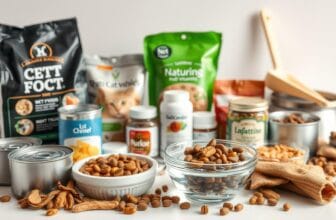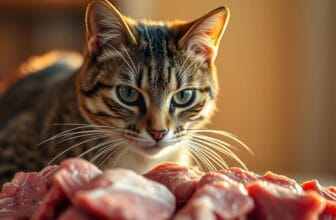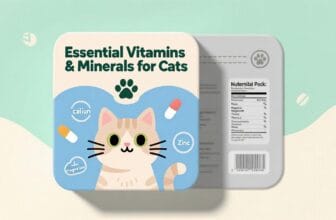
Table of Contents
Are you giving your cat the best nutrition? More pet owners are looking into advanced raw cat food. Freeze-dried cat food is a new choice that offers great nutrition and is easy to use.
The world of pet food is changing fast. Cat owners want better, more nutritious food than regular kibble. Freeze-dried cat food is a new way to feed cats. It keeps the nutrients in the food, making it closer to what cats eat in the wild.
This method keeps the food’s nutrients intact. It helps cats get the health benefits they need. Knowing about freeze-dried and dehydrated cat food helps you choose the right food for your cat.
Vets say it’s important to pick a diet that fits your cat’s health needs. Freeze-dried food has many benefits. But, talking to a vet is key to finding the best food for your cat.
In this guide, we’ll dive into freeze-dried cat food. We’ll look at how it’s made, its nutritional benefits, and what to consider. Every pet owner should know this.
Understanding the Basics of Raw Cat Food Processing
Raw cat food processing is a smart way to keep food natural. It’s a big step towards healthier eating for pets. Thanks to new technology, we can keep food safe and full of nutrients.
Raw food processing uses special techniques to meet your cat’s needs. It’s all about finding the best ways to give pets the nutrition they need.
Raw Food Processing Methods
Cat food makers use several methods to prepare raw ingredients:
- Freeze-drying: Removes moisture through sublimation
- Dehydration: Uses low heat to extract water content
- Cold-pressing: Preserves nutrients without high temperatures
- Vacuum-sealing: Protects food from oxidation
The Science of Moisture Removal
Getting rid of moisture is key in raw food processing. Freeze-drying is a top method. It turns water into vapor, keeping nutrients safe and sound.
Modern Processing Technologies
New cat food tech brings advanced methods to the table. These aim to:
- Keep nutrients from getting lost
- Make food last longer
- Keep protein quality high
- Ensure food is safe to eat
Learning about these methods helps you choose the best food for your cat. You can pick options that are both nutritious and well-preserved.
What Makes Freeze-Dried Cat Food Different
Freeze-dried cat food is a new way to keep raw food safe and nutritious. It’s different from regular cat food because it keeps the ingredients raw. This makes sure your cat gets the best nutrition possible.
This type of cat food is special because it offers top-notch nutrition. Here’s why:
- It keeps the natural nutrients in the food.
- It’s made with less processing than regular cat food.
- It tastes better and is more appealing to cats.
- It lasts longer without needing artificial preservatives.
Freeze-dried cat food is more than just food. It’s made by removing moisture but keeping all the good stuff. This makes it light and easy to store. You can feed it as a full meal, a tasty treat, or a healthy topping for their usual food.
People love how versatile freeze-dried cat food is. It’s great for traveling because it’s light. And it’s packed with protein and nutrients, making every bite count. The way it’s made keeps the flavors and nutrients in, unlike cooking methods that can lose them.
“Freeze-dried cat food represents the closest alternative to a cat’s natural diet, providing optimal nutrition in a convenient format.”
Choosing freeze-dried cat food means you’re picking a high-quality way to feed your cat. It’s made with care, keeping the nutrients in and the processing down.
The Dehydration Process Explained
Dehydrated cat food is a special way to feed pets. It removes moisture but keeps important nutrients. The process uses careful temperature control and timing to make raw ingredients into stable meals for cats.
Knowing how dehydration works helps cat owners choose better food for their pets. This method uses gentle heat to remove moisture, making a food product rich in nutrients.
Temperature and Time Requirements
The dehydration process has specific details that affect food quality:
- Temperature range: 95-165 degrees Fahrenheit
- Typical processing time: 6-12 hours
- Moisture reduction target: 10-15% remaining moisture
Impact on Nutritional Value
Dehydration’s effect on nutrition is complex, with some important points:
| Nutrient Category | Preservation Level | Potential Loss |
|---|---|---|
| Proteins | High | Minimal |
| Vitamins | Moderate | Some degradation |
| Enzymes | Low | Significant reduction |
Moisture Content Considerations
Dehydrated cat food’s low moisture is a big plus. Less water means more nutrients and longer shelf life. Your cat gets a dense nutritional package that saves space and stays fresh longer.
Choosing the right dehydrated cat food means understanding these detailed processes. This ensures your pet gets the best nutrition.
Comparing Freeze-Dried vs. Dehydrated Options
Choosing the right cat food is important. Knowing the difference between freeze-dried and dehydrated is key. These methods affect the food’s nutritional value and quality.
Freeze-dried and dehydrated cat foods have unique features. These features impact your cat’s diet. Let’s look at the main differences:
- Moisture Content: Freeze-dried foods have less moisture. This makes them last longer and keeps nutrients better.
- Nutrient Retention: Freeze-dried foods keep more vitamins and minerals than dehydrated ones.
- Texture and Palatability: Freeze-dried foods often taste better to cats.
Freeze-dried cat food has a big advantage. It uses a special method to preserve nutrients. This method freezes quickly and removes moisture, keeping nutrients in and making the food light and easy to store.
| Feature | Freeze-Dried | Dehydrated |
|---|---|---|
| Moisture Removal | Rapid freezing and vacuum removal | Slow heat-based removal |
| Nutrient Preservation | High retention | Moderate retention |
| Shelf Life | Longer | Shorter |
Choosing between freeze-dried and dehydrated cat food depends on your pet’s needs and your storage preferences. Each method has its own benefits. It’s important to understand these differences.
Nutritional Benefits of Freeze-Dried Cat Food
Freeze-dried cat food is a nutritional powerhouse for your cat. It keeps important nutrients in a way that regular pet food often can’t.
Your cat needs a lot of nutrients to stay healthy. Freeze-dried food is a great way to keep them at their best. It uses special techniques to keep nutrients fresh.
Protein Retention Rates
Protein is key for your cat’s diet. Freeze-dried foods keep protein levels high. This is because they use low temperatures to cook, unlike high-heat methods.
- Up to 98% protein preservation
- Minimal structural protein breakdown
- Enhanced amino acid profile
Vitamin and Mineral Conservation
Freeze-dried cat food is great at keeping nutrients safe. It uses gentle methods to protect vitamins and minerals from damage.
| Nutrient | Preservation Rate | Benefit |
|---|---|---|
| Vitamin A | 95% | Eye and immune health |
| Vitamin B Complex | 90% | Metabolic function |
| Calcium | 97% | Bone strength |
Enzyme Preservation Dynamics
Freeze-dried cat food is also good at keeping enzymes fresh. This is important for your cat’s digestion.
“Freeze-drying represents the gold standard in nutrient preservation for pet nutrition.” – Dr. Sarah Thompson, Veterinary Nutritionist
Choosing freeze-dried cat food means you’re picking a top-notch option. It supports your cat’s health with advanced preservation methods.
Safety Concerns and Food Handling

Raw cat food safety is key to keep your cat and home safe. It’s important to know how to handle freeze-dried or raw cat food safely.
Bacteria like E. coli, Salmonella, and Listeria are big risks with raw cat food. These pathogens can make your cat and family sick.
To avoid these risks, keep your hands and surfaces clean. Proper food handling can greatly lower the chance of bacteria spreading.
| Safety Precaution | Recommended Action |
|---|---|
| Preparation Surface | Sanitize with antibacterial cleaner before and after food preparation |
| Utensils | Use dedicated tools for raw food, wash thoroughly with hot water |
| Hand Hygiene | Wash hands with soap for 20 seconds before and after handling |
| Storage | Keep raw food refrigerated at proper temperatures |
If you or a family member has a weak immune system, be extra careful. Talk to your vet about safe handling for your cat’s food.
Veterinary experts recommend treating raw cat food with the same careful handling as raw human food.
By sticking to these safety tips, you can keep your cat healthy and reduce the risk of contamination.
Storage Requirements and Shelf Life
Keeping freeze-dried cat food fresh is key. It’s all about how well you store it. This ensures your cat gets the best nutrition.
Essential Storage Practices
Here are some important steps to keep your cat’s food fresh:
- Store in a cool, dry place away from direct sunlight
- Keep the original packaging sealed tightly
- Maintain consistent room temperature between 50-70°F
- Use airtight containers for opened packages
Understanding Shelf Life
Freeze-dried cat food can last 12-24 months if stored right. Unopened packages usually last longer. Always check the expiration date for the best nutrition.
Recognizing Food Spoilage
Look out for these signs of spoiled food:
- Unusual odors
- Discoloration
- Visible moisture or clumping
- Presence of mold
Pro tip: Always inspect your cat’s food before serving, regardless of the package’s stated shelf life.
Once a package is open, refrigeration is a must. Use the food within 7-14 days. Never leave it out for too long to avoid bacterial growth.
How to Prepare Freeze-Dried Cat Food
Preparing freeze-dried cat food needs careful steps. Different ways to rehydrate it can make a nutritious meal for your cat. Knowing the best methods ensures your cat gets the nutrients they need and enjoys their food.
Most freeze-dried cat foods come with specific instructions. Here are some general tips for successful preparation:
- Always check the product packaging for specific rehydration instructions
- Use room temperature filtered water or pet-safe broth
- Measure the recommended water-to-food ratio precisely
- Mix thoroughly to ensure even hydration
The rehydration process is simple:
- Measure the desired amount of freeze-dried cat food
- Add the appropriate amount of liquid
- Let the food sit for 3-5 minutes
- Stir gently to create a consistent texture
“Proper preparation is key to maintaining the nutritional integrity of freeze-dried cat food.” – Veterinary Nutrition Experts
Some cats like their food a bit warmer. You can gently warm the rehydrated meal to body temperature. Be careful not to overheat, as this can destroy valuable nutrients. Always test the temperature before serving to prevent potential burns.
When switching to freeze-dried cat food, introduce it slowly. Start by mixing a small amount of freeze-dried food with your cat’s current diet. Slowly increase the proportion over 7-10 days.
Cost Considerations and Value Analysis
It’s important for pet owners to understand the cost of freeze-dried cat food. This type of food can be more expensive than regular pet food. So, it’s key to look at the value it offers.

- Premium ingredient quality
- Advanced processing techniques
- Nutritional density
- Preservation methods
Price Comparison Insights
Freeze-dried cat food costs between $2 and $5 per serving. This is more than traditional wet or dry food, which costs $0.50 to $1.50 per serving. But, the extra cost might be worth it for the nutritional benefits.
Economic Considerations for Cat Owners
You don’t have to switch completely to freeze-dried food. Here are some budget-friendly ideas:
- Use as a nutritional topper
- Mix with existing food
- Rotate with more affordable options
- Purchase during promotional periods
The true value goes beyond just the cost. It can also help save on vet bills by keeping your cat healthy.
Investing in quality nutrition can be a proactive approach to your cat’s long-term wellness.
Health Benefits and Potential Risks
Exploring freeze-dried cat food reveals a complex world of nutrition for cats. There are both benefits and risks to consider. It’s important to weigh these carefully.
The health benefits of freeze-dried cat food include:
- Enhanced nutrient preservation compared to traditional processed foods
- Improved digestive function
- Potential reduction in allergen exposure
- Higher protein concentration
Veterinary nutritionists warn about the risks of raw diets. Bacterial contamination is a big concern. Pathogenic organisms like Salmonella and E. coli can pose serious health threats to both cats and their human families.
| Health Aspect | Freeze-Dried Food Impact |
|---|---|
| Digestibility | Typically Higher |
| Bacterial Risk | Moderate to High |
| Nutrient Retention | Excellent |
Before switching to freeze-dried cat food, talk to your vet. They can give advice tailored to your cat’s needs. This includes their health, age, and any medical conditions.
Freeze-dried cat food has its benefits, but it’s crucial to be aware of the risks. Responsible pet care means choosing the right food for your cat’s health. This ensures their well-being for years to come.
Transitioning Your Cat to Freeze-Dried Food
Changing your cat’s food needs careful planning and patience. A smooth transition to freeze-dried food is key. It helps your cat adjust without digestive stress and ensures they like the new food.
Vets suggest a strategic way to introduce new food. Cats need time to get used to new tastes and textures.
Creating a Gradual Transition Plan
A step-by-step plan is crucial to avoid digestive problems. Here’s a suggested plan:
- Days 1-3: Mix 25% new freeze-dried food with 75% current diet
- Days 4-6: Blend 50% new and 50% current food
- Days 7-9: Increase to 75% freeze-dried food, 25% original diet
- Days 10-14: Complete transition to 100% freeze-dried food
Monitoring Your Cat’s Response
Keep an eye on these important signs during the transition:
- Appetite levels
- Energy changes
- Digestive comfort
- Coat and skin condition
Pro tip: Always talk to your vet before big changes in your cat’s diet, especially if they have health issues.
Understanding AAFCO Standards and Regulations

Choosing the right cat food is key for your pet’s health. The Association of American Feed Control Officials (AAFCO) sets important rules. These rules help keep your cat safe and healthy.
AAFCO makes detailed guidelines for cat food. These guidelines ensure cat foods have the right nutrients. They help you pick safe and healthy food for your cat.
- AAFCO defines nutritional profiles for different cat life stages
- Establishes minimum nutrient requirements for cat foods
- Provides guidelines for labeling and ingredient quality
Look for the AAFCO statement on cat food labels. It shows the food is complete and balanced for your cat’s life stage.
“A food that meets AAFCO standards ensures your cat receives essential nutrients for optimal health.”
Freeze-dried and raw cat foods also follow these strict rules. Manufacturers must prove their products meet AAFCO’s standards through tests.
Knowing these standards helps you choose the best food for your cat. This ensures they get the nutrition they need.
Choosing the Right Brand for Your Cat
Choosing cat food is a big deal. It’s all about what your cat needs to stay healthy. When looking at freeze-dried cat food, there are key things to think about.
First, check the ingredients and how complete the nutrition is. Look for brands that follow AAFCO standards and are open about where they get their ingredients.
- Check protein sources as the first ingredient
- Verify minimal processing techniques
- Research brand reputation and customer reviews
- Consider your cat’s specific health requirements
Choose brands that focus on quality nutrition. Some of the best freeze-dried cat food brands are:
| Brand | Key Features | Price Range |
|---|---|---|
| Stella & Chewy’s | Organic ingredients, multiple protein options | $$$ |
| Primal Pet Foods | Grass-fed meats, no artificial preservatives | $$ |
| Instinct Raw | Grain-free, cage-free chicken | $$ |
Remember that individual cats may have different preferences and dietary needs. Talk to your vet to find the best freeze-dried cat food for your pet.
Professional tip: Gradually introduce new foods to prevent digestive issues and monitor your cat’s response.
Common Misconceptions About Raw Diets
It can be tough for pet owners to sort through raw cat food myths. Many false beliefs about freeze-dried diets confuse people about what’s best for cats.
To understand the truth, we need to look at scientific evidence. Some think raw diets are always better, but it’s not that simple.
Debunking Popular Raw Diet Claims
- Myth: Raw diets are inherently healthier for cats
- Myth: Cats in the wild only consume raw food
- Myth: All commercially processed cat foods lack nutritional value
Veterinary nutritionists have studied freeze-dried diets a lot. They found that not all raw diets are complete. Cats need meals that are balanced and meet certain nutritional standards.
Scientific Evidence and Research
| Claim | Scientific Perspective |
|---|---|
| Raw diets prevent diseases | No conclusive peer-reviewed evidence supports this claim |
| Raw food mimics natural diet | Domesticated cats have different nutritional needs than wild ancestors |
| Freeze-dried food is always safe | Proper handling and quality control are crucial |
When looking at raw cat food myths, it’s key to trust evidence-based info. Consult with veterinary professionals to make smart choices for your cat’s diet.
Remember, every cat is different. What’s good for one might not be for another. Always think about your cat’s specific health needs when choosing a diet.
Conclusion
Choosing the right freeze-dried cat food is a big decision. Every cat is different, and knowing about food processing helps you pick the best. This ensures your cat gets the nutrients they need.
Freeze-dried cat food has its perks, like keeping nutrients fresh and being easy to serve. But, think about the cost, nutritional value, and your cat’s taste before switching. It’s important to consider these factors carefully.
Getting advice from your vet is key when trying new foods. They can help you choose based on your cat’s health, age, and diet needs. Keeping an eye on your cat’s health and adjusting their diet as needed is crucial.
But diet is only part of caring for your pet. Make sure to also give them regular vet visits, playtime, and lots of love. This shows you truly care about their health and happiness.
FAQ
What is the difference between freeze-dried and dehydrated cat food?
Freeze-dried cat food is made by removing moisture at very low temperatures. This keeps more nutrients and keeps the food raw. Dehydrated food uses heat, which might reduce nutrients and enzyme activity.
Freeze-dried food usually has more nutrients and a lighter texture than dehydrated food.
Is freeze-dried cat food safe for my cat?
Freeze-dried cat food can be safe if handled correctly. Buy from trusted brands that follow food safety rules. Always wash your hands well and avoid mixing foods.
If you or your cat have weak immune systems, talk to your vet before trying raw or freeze-dried foods.
How do I transition my cat to freeze-dried food?
Start by adding a little freeze-dried food to their regular diet. Mix it in slowly over 7-10 days. Watch for any digestive problems or changes in appetite.
Some cats like freeze-dried food better when it’s mixed with warm water or broth. This makes it smell and taste better.
How long can freeze-dried cat food be stored?
Freeze-dried cat food lasts 12-24 months if stored right. Check the packaging for storage tips and an expiration date. Keep it in a cool, dry place away from sunlight.
Once opened, use it within 30-45 days. Store it in a sealed container.
Are freeze-dried foods more expensive than traditional cat food?
Yes, freeze-dried cat food costs more per serving than kibble or canned food. The price reflects the advanced processing, quality ingredients, and nutrient preservation. But many pet owners think the health benefits are worth it.
Can freeze-dried food be used as a complete diet for cats?
Some freeze-dried foods are complete diets, but check the packaging for the AAFCO statement. Not all freeze-dried foods meet all nutritional needs. Always talk to a vet to make sure it’s right for your cat.
How do I prepare freeze-dried cat food?
You can serve freeze-dried cat food as is or rehydrate it. Follow the package’s water ratio instructions. Add warm water and let it sit for a few minutes to rehydrate.
Some cats prefer it at room temperature. Avoid hot water to keep nutrients safe.
Are there any risks associated with raw or freeze-dried cat foods?
Raw or freeze-dried foods can have risks like bacterial contamination and nutritional imbalances. These risks can be lowered by buying from trusted brands and following proper handling. Cats with weak immune systems or health issues might need to avoid these foods.







